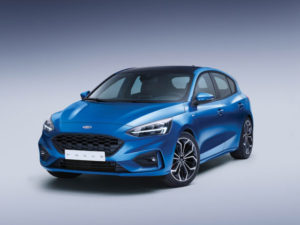Spotlight: Ford Focus
The fourth-generation Focus is a technological showpiece, out to re-assert itself in a segment that’s still a core part of Europe’s fleet market. Alex Grant finds out how.
A clean sheet
Ford says the newcomer is designed from a clean sheet; a new platform with a stiffer structure and longer wheelbase, creating space for larger wheels and pushing the cabin rearwards for a sportier silhouette. For the first time, not all versions will include Ford’s sophisticated independent rear suspension – a hallmark of the nameplate since 1998. A simpler twist beam will be used on cars with less than 125hp.
The range will comprise five-door hatch and sedan, and a new wagon featuring a taller, longer boot than the outgoing car, with under-floor storage for the load cover and an electrically-operated tailgate. Two-piece rear lamps means there’s a wider tailgate opening for getting bulky objects inside.
Easier living
Higher-quality materials and a simpler, more intuitive dashboard with controls relocated to its central touchscreen move the cabin on from its predecessor, with a view to making it easier to live with. This will be the first model with the FordPass Connect on-board modem, offering WiFi for up to 10 devices, live traffic, and a smartphone app with remote status checks and the option to unlock and start the car.
The outgoing Focus had brought autonomous braking and park assist into its segment, and the new car gets the latest technology in the Ford portfolio. This includes adaptive cruise control with active lane keeping and the ability to stop and start in traffic jams, as well as adjusting its speed based on roadside signs. Park Assist 2 enables hands-free, feet-free parking, by pressing a button on the centre console.
Broader appeal
Falling in line with the new Ka and Fiesta, Ford will offer sports-tuned ST-Line, luxurious Vignale and SUV-inspired Active versions alongside the Zetec and Titanium trims. All feature new selectable driving modes, and there’s an option to add adaptive dampers which can pre-adjust suspension settings for taut handling or to counteract bumps and potholes.
But the engine line-up is familiar from the old car, with European markets likely to favour the 1.0-litre EcoBoost petrol (with 85hp, 100hp or 125hp) or 1.5-litre EcoBlue diesel (at 95hp or 120hp). The EcoBoost unit can operate on two of its three cylinders under low loads to save fuel, bringing CO2 emissions down to a target of 108g/km, while the diesel will emit an estimated 94g/km. Ford will also offer 1.5-litre EcoBoost (150hp or 182hp) petrols and a 150hp EcoBlue diesel, while an eight-speed automatic transmission will be available for engines at 120hp or more.
What we think…
Despite the popularity of premium brands and SUVs across Europe, the Focus is a core offer for Ford, accounting for a fifth of its volume, or 214,661 units, according to JATO data. So the new car is a showcase for its newest technology and, while not all of this will be relevant to fleets, improvements to connectivity, refinement and cargo capacity will all be welcomed by end-users. It will be interesting to see if this generation has a broader role for electric versions, though.
Fleet Fact
SUV-inspired Active version features 30mm extra ground clearance.








